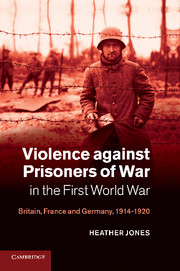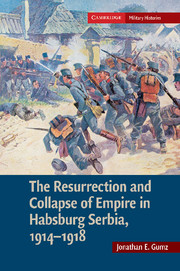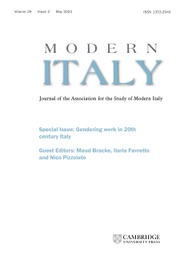Violence against Prisoners of War in the First World War
Britain, France and Germany, 1914–1920
Part of Studies in the Social and Cultural History of Modern Warfare
- Author: Heather Jones, University College London
- Date Published: August 2013
- availability: Available
- format: Paperback
- isbn: 9781107638266
Paperback
Other available formats:
Hardback, eBook
Looking for an inspection copy?
This title is not currently available on inspection
-
In this groundbreaking study, Heather Jones provides the first in-depth and comparative examination of violence against First World War prisoners. She shows how the war radicalised captivity treatment in Britain, France and Germany, dramatically undermined international law protecting prisoners of war and led to new forms of forced prisoner labour and reprisals, which fuelled wartime propaganda that was often based on accurate prisoner testimony. This book reveals how, during the conflict, increasing numbers of captives were not sent to home front camps but retained in western front working units to labour directly for the British, French and German armies - in the German case, by 1918, prisoners working for the German army endured widespread malnutrition and constant beatings. Dr Jones examines the significance of these new, violent trends and their later legacy, arguing that the Great War marked a key turning-point in the twentieth-century evolution of the prison camp.
Read more- The first comparative transnational study of violence against British, French and German First World War prisoners of war captured on the Western Front
- Combines cultural and military history approaches
- Uncovers the contrasting conditions between home front and front line prisoner-of-war camps, and how the war undermined international laws protecting prisoners
Reviews & endorsements
'Although it refers to several existing studies, Heather Jones's book, based upon a wide array of sources, goes far beyond them … Altogether, this study makes an important contribution to a long-neglected topic.' Michael Epkenhans, Frankfurter Allgemeine Zeitung
See more reviews'This excellent work is based on extensive archival research.' The Times Literary Supplement
'Thanks to its impressive scope, the book promises to become a necessary read for students of the war and a go-to book on POWs more broadly speaking. For scholars of World War I, Jones's study will be critical for her contributions to the contextualization of wartime violence.' Caroline Shaw, Journal of British Studies
'… an important work that explores the dynamic relationships that drove Britain, France, and especially Germany to adopt increasingly harsh methods in dealing with military prisoners.' American Historical Review
Customer reviews
Not yet reviewed
Be the first to review
Review was not posted due to profanity
×Product details
- Date Published: August 2013
- format: Paperback
- isbn: 9781107638266
- length: 468 pages
- dimensions: 229 x 152 x 23 mm
- weight: 0.6kg
- contains: 20 b/w illus. 12 tables
- availability: Available
Table of Contents
Introduction
Part I. Propaganda Representations of Violence Against Prisoners:
1. Encountering the 'enemy': civilian violence towards prisoners of war in 1914
2. Legitimate and illegitimate violence against prisoners: representations of atrocity, 1914–16
Part II. Violence and Prisoner of War Forced Labour:
3. The development of prisoner of war labour companies on the Western Front: the spring reprisals of 1917
4. From discipline to retribution: violence in German prisoner of war labour companies in 1918
5. Inevitable escalation? British and French treatment of forced prisoner labour, 1917–18
Part III. The End of Violence? Repatriation and Remembrance:
6. Contested homecomings: prisoner repatriation and the formation of memory, 1918–21
7. La grande illusion: the interwar historicisation of violence against prisoners of war, 1922–39
Epilogue: the legacy of First World War captivity in 1939–45
Conclusion.
Sorry, this resource is locked
Please register or sign in to request access. If you are having problems accessing these resources please email [email protected]
Register Sign in» Proceed
You are now leaving the Cambridge University Press website. Your eBook purchase and download will be completed by our partner www.ebooks.com. Please see the permission section of the www.ebooks.com catalogue page for details of the print & copy limits on our eBooks.
Continue ×Are you sure you want to delete your account?
This cannot be undone.
Thank you for your feedback which will help us improve our service.
If you requested a response, we will make sure to get back to you shortly.
×




.jpg)


.jpg)
